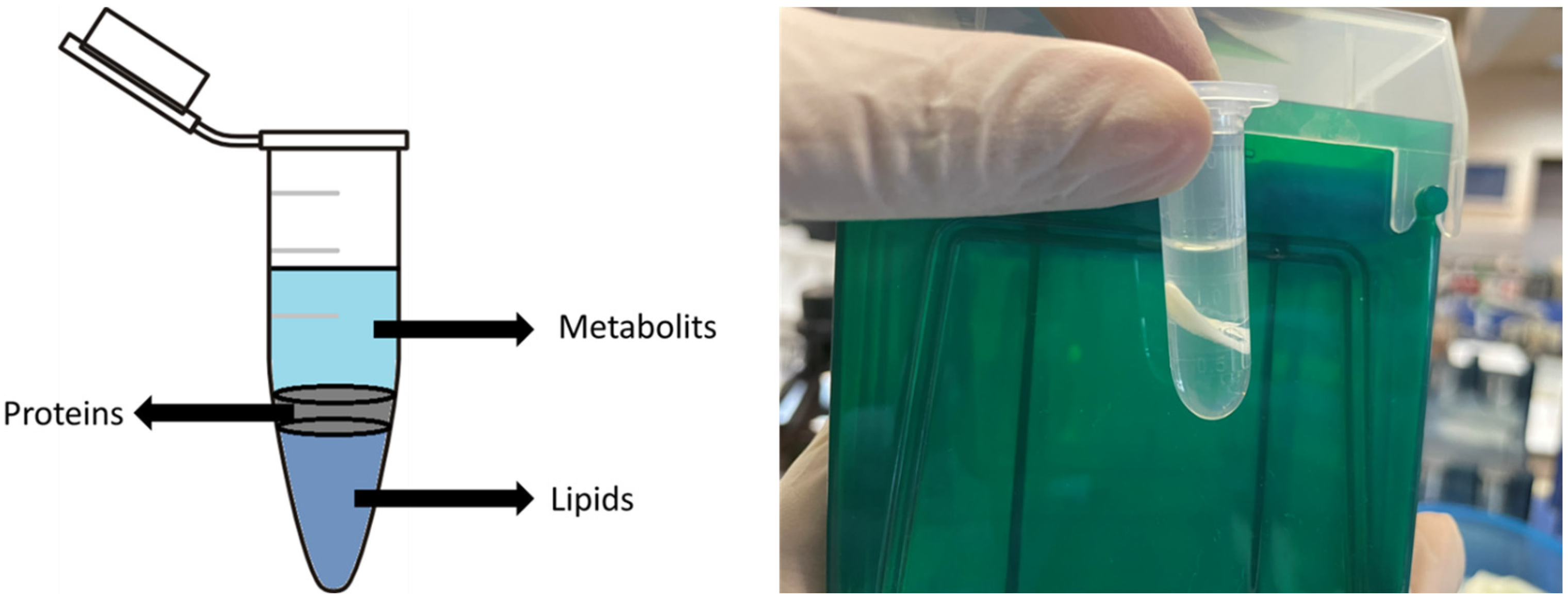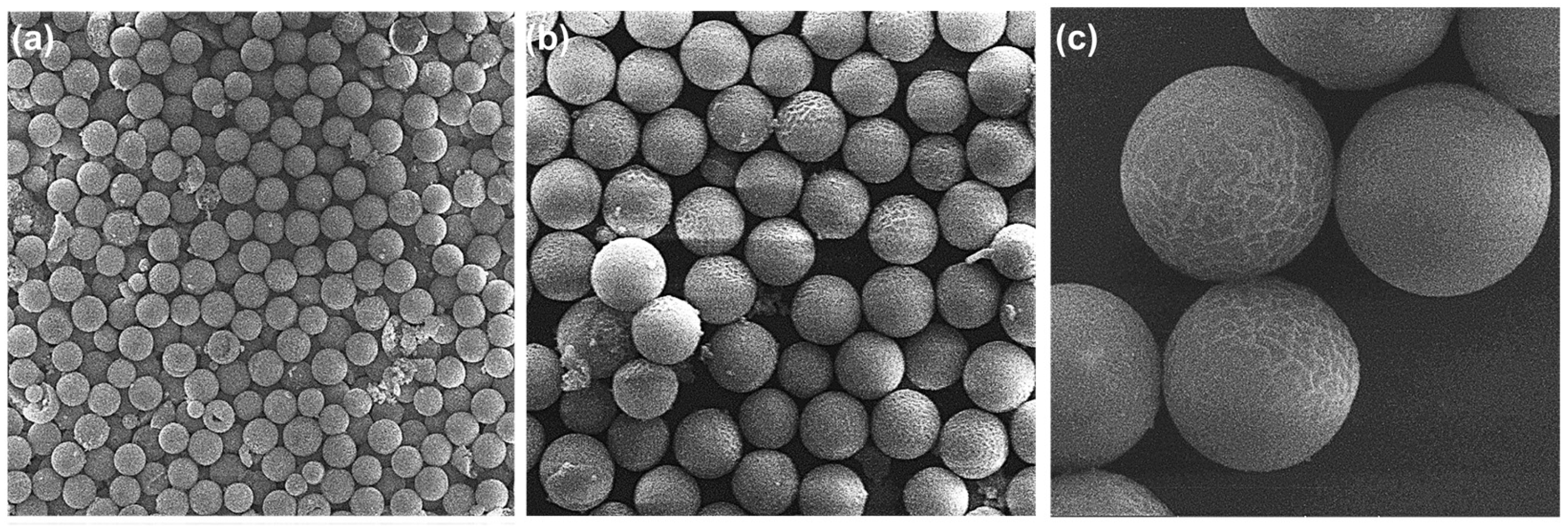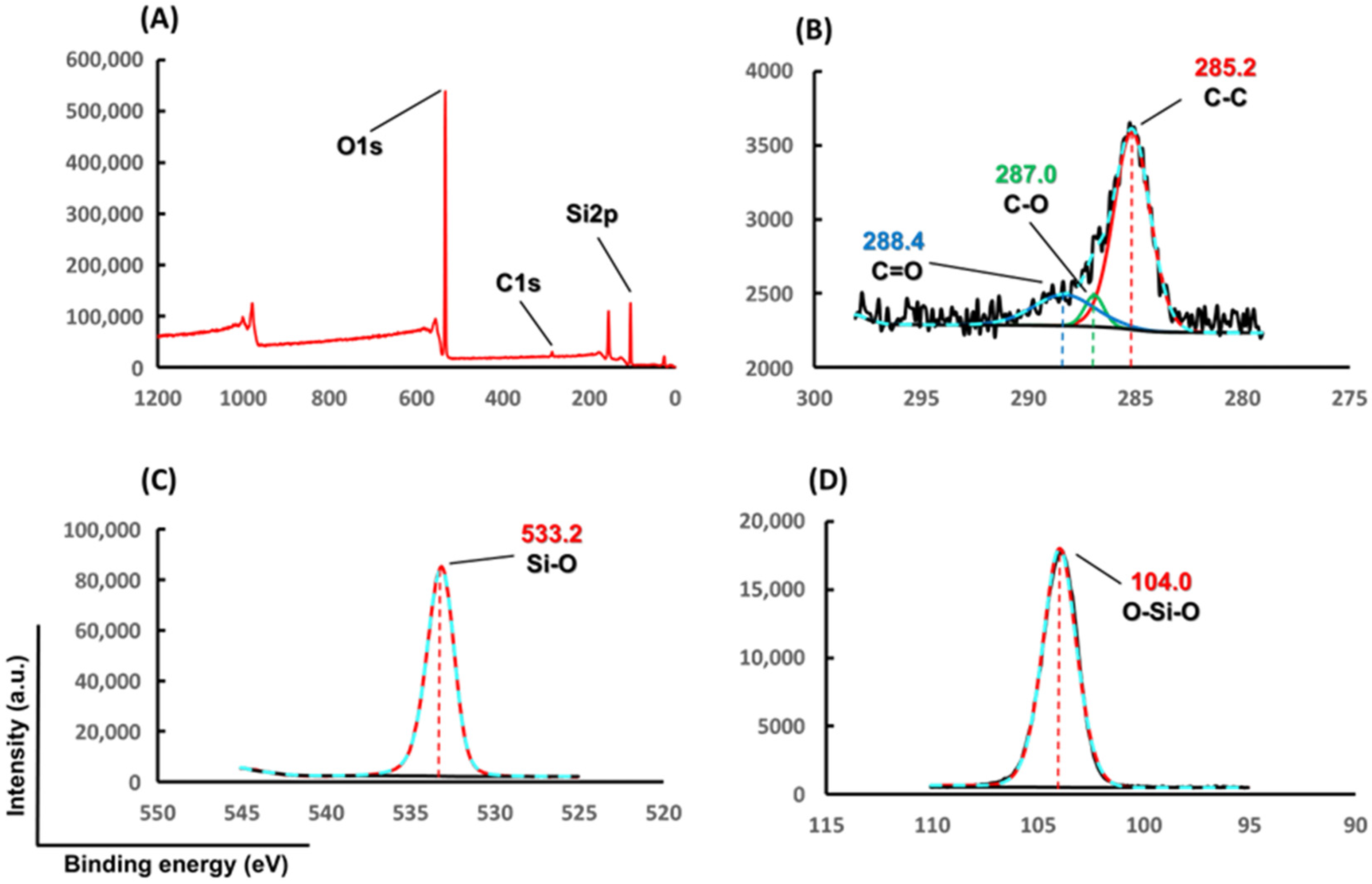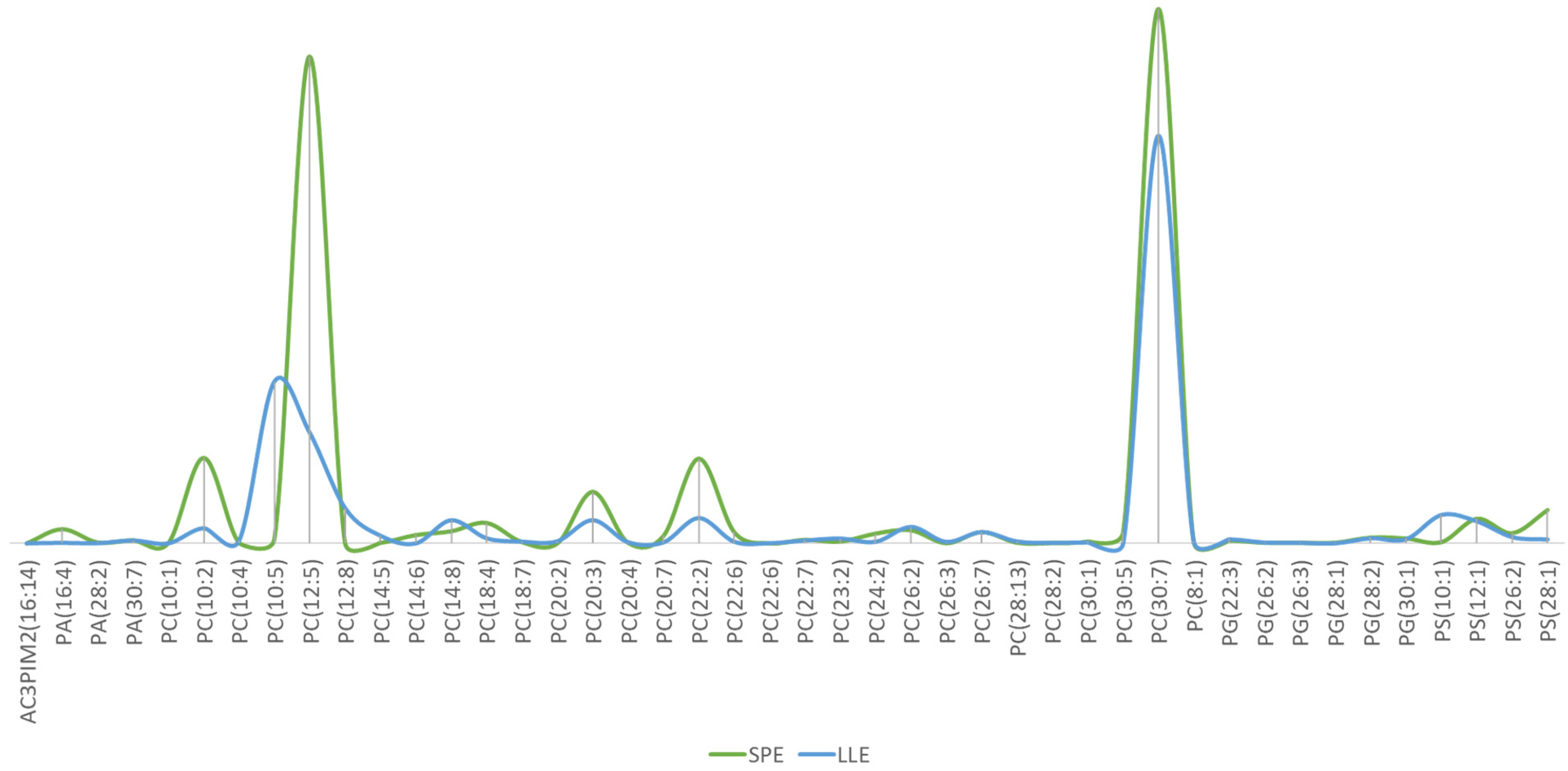A Facile and Efficient Protocol for Phospholipid Enrichment in Synovial Joint Fluid: Monodisperse-Mesoporous SiO2 Microspheres as a New Metal Oxide Affinity Sorbent
Abstract
:1. Introduction
2. Materials and Methods
2.1. Chemicals and Reagents
2.2. Preparation of Monodisperse-Mesoporous SiO2 Metal Oxide Affinity Sorbent
2.3. Characterization of SiO2 Microspheres
2.4. Synovial Joint Fluid Sample Collection
2.5. Selective Extraction of PLs Using Monodisperse-Mesoporous SiO2 Microspheres
2.6. Q-TOF LC/MS Analysis
2.7. Data Pre-Processing and Analyses
3. Results
3.1. Characterization of Monodisperse-Mesoporous SiO2 Microspheres
3.2. Q-TOF LC/MS-Based Lipidomics Results
4. Discussion
5. Limitations
6. Conclusions
Author Contributions
Funding
Institutional Review Board Statement
Informed Consent Statement
Data Availability Statement
Acknowledgments
Conflicts of Interest
References
- Kraus, V.B.; Blanco, F.J.; Englund, M.; Karsdal, M.A.; Lohmander, L.S. Call for standardized definitions of osteoarthritis and risk stratification for clinical trials and clinical use. Osteoarthr. Cartil. 2015, 23, 1233–1241. [Google Scholar] [CrossRef]
- Martel-Pelletier, J.; Barr, A.J.; Cicuttini, F.M.; Conaghan, P.G.; Cooper, C.; Goldring, M.B.; Goldring, S.R.; Jones, G.; Teichtahl, A.J.; Pelletier, J.P. Osteoarthritis. Nat. Rev. Dis. Primers 2016, 2, 16072. [Google Scholar] [CrossRef]
- Goldring, S.R.; Goldring, M.B. Changes in the osteochondral unit during osteoarthritis: Structure, function and cartilage-bone crosstalk. Nat. Rev. Rheumatol. 2016, 12, 632–644. [Google Scholar] [CrossRef] [PubMed]
- Deveza, L.A.; Melo, L.; Yamato, T.P.; Mills, K.; Ravi, V.; Hunter, D.J. Knee osteoarthritis phenotypes and their relevance for outcomes: A systematic review. Osteoarthr. Cartil. 2017, 25, 1926–1941. [Google Scholar] [CrossRef]
- Rocha, B.; Illiano, A.; Calamia, V.; Pinto, G.; Amoresano, A.; Ruiz-Romero, C.; Blanco, F.J. Targeted phospholipidomic analysis of synovial fluid as a tool for osteoarthritis deep phenotyping. Osteoarthr. Cartil. Open 2021, 3, 100219. [Google Scholar] [CrossRef] [PubMed]
- Priori, R.; Scrivo, R.; Brandt, J.; Valerio, M.; Casadei, L.; Valesini, G.; Manetti, C. Metabolomics in rheumatic diseases: The potential of an emerging methodology for improved patient diagnosis, prognosis, and treatment efficacy. Autoimmun. Rev. 2013, 12, 1022–1030. [Google Scholar] [CrossRef]
- Zhang, W.; Sun, G.; Likhodii, S.; Liu, M.; Aref-Eshghi, E.; Harper, P.E.; Martin, G.; Furey, A.; Green, R.; Randell, E.; et al. Metabolomic analysis of human plasma reveals that arginine is depleted in knee osteoarthritis patients. Osteoarthr. Cartil. 2016, 24, 827–834. [Google Scholar] [CrossRef]
- Zhai, G.; Sun, X.; Randell, E.W.; Liu, M.; Wang, N.; Tolstykh, I.; Rahman, P.; Torner, J.; Lewis, C.E.; Nevitt, M.C.; et al. Phenylalanine Is a Novel Marker for Radiographic Knee Osteoarthritis Progression: The MOST Study. J. Rheumatol. 2021, 48, 123–128. [Google Scholar] [CrossRef]
- Zhang, W.; Sun, G.; Aitken, D.; Likhodii, S.; Liu, M.; Martin, G.; Furey, A.; Randell, E.; Rahman, P.; Jones, G.; et al. Lysophosphatidylcholines to phosphatidylcholines ratio predicts advanced knee osteoarthritis. Rheumatology 2016, 55, 1566–1574. [Google Scholar] [CrossRef]
- Zhai, G.; Pelletier, J.P.; Liu, M.; Aitken, D.; Randell, E.; Rahman, P.; Jones, G.; Martel-Pelletier, J. Activation of The Phosphatidylcholine to Lysophosphatidylcholine Pathway Is Associated with Osteoarthritis Knee Cartilage Volume Loss Over Time. Sci. Rep. 2019, 9, 9648. [Google Scholar] [CrossRef]
- Jaggard, M.K.J.; Boulangé, C.L.; Graça, G.; Vaghela, U.; Akhbari, P.; Bhattacharya, R.; Williams, H.R.T.; Lindon, J.C.; Gupte, C.M. Can metabolic profiling provide a new description of osteoarthritis and enable a personalised medicine approach? Clin. Rheumatol. 2020, 39, 3875–3882. [Google Scholar] [CrossRef]
- Kosinska, M.K.; Liebisch, G.; Lochnit, G.; Wilhelm, J.; Klein, H.; Kaesser, U.; Lasczkowski, G.; Rickert, M.; Schmitz, G.; Steinmeyer, J. Sphingolipids in human synovial fluid—A lipidomic study. PLoS ONE 2014, 9, e91769. [Google Scholar] [CrossRef]
- Bian, J.; Xue, Y.; Yao, K.; Gu, X.; Yan, C.; Wang, Y. Solid-phase extraction approach for phospholipids profiling by titania-coated silica microspheres prior to reversed-phase liquid chromatography-evaporative light scattering detection and tandem mass spectrometry analysis. Talanta 2014, 123, 233–240. [Google Scholar] [CrossRef] [PubMed]
- Bellamy, N.; Campbell, J.; Welch, V.; Gee, T.L.; Bourne, R.; Wells, G.A. Viscosupplementation for the treatment of osteoarthritis of the knee. Cochrane Database Syst. Rev. 2006, 2006, CD005321. [Google Scholar] [CrossRef] [PubMed]
- Ludwig, T.E.; McAllister, J.R.; Lun, V.; Wiley, J.P.; Schmidt, T.A. Diminished cartilage-lubricating ability of human osteoarthritic synovial fluid deficient in proteoglycan 4: Restoration through proteoglycan 4 supplementation. Arthritis Rheum. 2012, 64, 3963–3971. [Google Scholar] [CrossRef] [PubMed]
- Sun, K.; Shoaib, T.; Rutland, M.W.; Beller, J.; Do, C.; Espinosa-Marzal, R.M. Insight into the assembly of lipid-hyaluronan complexes in osteoarthritic conditions. Biointerphases 2023, 18, 021005. [Google Scholar] [CrossRef]
- Sarma, A.V.; Powell, G.L.; LaBerge, M. Phospholipid composition of articular cartilage boundary lubricant. J. Orthop. Res. 2001, 19, 671–676. [Google Scholar] [CrossRef]
- Kosinska, M.K.; Liebisch, G.; Lochnit, G.; Wilhelm, J.; Klein, H.; Kaesser, U.; Lasczkowski, G.; Rickert, M.; Schmitz, G.; Steinmeyer, J. A lipidomic study of phospholipid classes and species in human synovial fluid. Arthritis Rheum. 2013, 65, 2323–2333. [Google Scholar] [CrossRef] [PubMed]
- Pawlak, Z.; Mrela, A.; Kaczmarek, M.; Cieszko, M.; Urbaniak, W. Natural joints: Boundary lubrication and antiphospholipid syndrome (APS). Biosystems 2019, 177, 44–47. [Google Scholar] [CrossRef]
- Mazzucco, D.; Scott, R.; Spector, M. Composition of joint fluid in patients undergoing total knee replacement and revision arthroplasty: Correlation with flow properties. Biomaterials 2004, 25, 4433–4445. [Google Scholar] [CrossRef]
- Schmidt, T.A.; Gastelum, N.S.; Nguyen, Q.T.; Schumacher, B.L.; Sah, R.L. Boundary lubrication of articular cartilage: Role of synovial fluid constituents. Arthritis Rheum. 2007, 56, 882–891. [Google Scholar] [CrossRef] [PubMed]
- Sabatini, M.; Thomas, M.; Deschamps, C.; Lesur, C.; Rolland, G.; de Nanteuil, G.; Bonnet, J. Effects of ceramide on aggrecanase activity in rabbit articular cartilage. Biochem. Biophys. Res. Commun. 2001, 283, 1105–1110. [Google Scholar] [CrossRef]
- Liebisch, G.; Drobnik, W.; Lieser, B.; Schmitz, G. High-throughput quantification of lysophosphatidylcholine by electrospray ionization tandem mass spectrometry. Clin. Chem. 2002, 48, 2217–2224. [Google Scholar] [CrossRef] [PubMed]
- Fahy, E.; Subramaniam, S.; Murphy, R.C.; Nishijima, M.; Raetz, C.R.; Shimizu, T.; Spener, F.; van Meer, G.; Wakelam, M.J.; Dennis, E.A. Update of the LIPID MAPS comprehensive classification system for lipids. J. Lipid Res. 2009, 50, S9–S14. [Google Scholar] [CrossRef]
- Henry, S.A.; Kohlwein, S.D.; Carman, G.M. Metabolism and regulation of glycerolipids in the yeast Saccharomyces cerevisiae. Genetics 2012, 190, 317–349. [Google Scholar] [CrossRef]
- Bligh, E.G.; Dyer, W.J. A rapid method of total lipid extraction and purification. Can. J. Biochem. Physiol. 1959, 37, 911–917. [Google Scholar] [CrossRef] [PubMed]
- Ruiz-Gutiérrez, V.; Pérez-Camino, M.C. Update on solid-phase extraction for the analysis of lipid classes and related compounds. J. Chromatogr. A 2000, 885, 321–341. [Google Scholar] [CrossRef]
- Nelson, C.A.; Szczech, J.R.; Xu, Q.; Lawrence, M.J.; Jin, S.; Ge, Y. Mesoporous zirconium oxide nanomaterials effectively enrich phosphopeptides for mass spectrometry-based phosphoproteomics. Chem. Commun. 2009, 43, 6607–6609. [Google Scholar] [CrossRef]
- Kweon, H.K.; Håkansson, K. Selective zirconium dioxide-based enrichment of phosphorylated peptides for mass spectrometric analysis. Anal. Chem. 2006, 78, 1743–1749. [Google Scholar] [CrossRef]
- Khoury, S.; Colas, J.; Breuil, V.; Kosek, E.; Ahmed, A.S.; Svensson, C.I.; Marchand, F.; Deval, E.; Ferreira, T. Identification of Lipid Biomarkers for Chronic Joint Pain Associated with Different Joint Diseases. Biomolecules 2023, 13, 342. [Google Scholar] [CrossRef]
- Kosinska, M.K.; Ludwig, T.E.; Liebisch, G.; Zhang, R.; Siebert, H.C.; Wilhelm, J.; Kaesser, U.; Dettmeyer, R.B.; Klein, H.; Ishaque, B.; et al. Articular Joint Lubricants during Osteoarthritis and Rheumatoid Arthritis Display Altered Levels and Molecular Species. PLoS ONE 2015, 10, e0125192. [Google Scholar] [CrossRef] [PubMed]
- Koh, J.H.; Yoon, S.J.; Kim, M.; Cho, S.; Lim, J.; Park, Y.; Kim, H.S.; Kwon, S.W.; Kim, W.U. Lipidome profile predictive of disease evolution and activity in rheumatoid arthritis. Exp. Mol. Med. 2022, 54, 143–155. [Google Scholar] [CrossRef] [PubMed]
- Van de Vyver, A.; Clockaerts, S.; van de Lest, C.H.A.; Wei, W.; Verhaar, J.; Van Osch, G.J.V.M.; Bastiaansen-Jenniskens, Y.M. Synovial Fluid Fatty Acid Profiles Differ between Osteoarthritis and Healthy Patients. Cartilage 2020, 11, 473–478. [Google Scholar] [CrossRef] [PubMed]
- Salimi, K.; Usta, D.D.; Çelikbıçak, Ö.; Pinar, A.; Salih, B.; Tuncel, A. Ti(IV) carrying polydopamine-coated, monodisperse-porous SiO2 microspheres with stable magnetic properties for highly selective enrichment of phosphopeptides. Colloids Surf. B Biointerfaces 2017, 153, 280–290. [Google Scholar] [CrossRef] [PubMed]
- Folch, J.M.L.; Lees, M.P.; Stanley, G.H.A. A Simple Method for the Isolation and Purification of Total Lipides from Animal Tissues. J. Biol. Chem. 1957, 226, 497–509. [Google Scholar] [CrossRef]
- Tosun, R.B.; Hamaloglu, K.O.; Tuncel, A. Bimetallic Pd-Au nanoparticles supported monodisperse porous silica microspheres as an efficient heterogenous catalyst for fast oxidation of benzyl alcohol. ChemistrySelect 2022, 7, e202201646. [Google Scholar] [CrossRef]
- Al-Qurahi, M.A.A.; Demir, M.; Tümer, B.; Gökçal, B.; Tuncel, A. Formic acid dehydrogenation catalyzed by bimetallic nanoalloys supported by monodisperse-porous microspheres: Catalytic and visible light driven photocatalytic hydrogen generation. Int. J. Hydrogen Energy 2024, 51, 111–132. [Google Scholar] [CrossRef]
- Elmas, B.; Tuncel, M.; Yalçın, G.; Şenel, S.; Tuncel, A. Synthesis of uniform, fluorescent poly (glycidyl methacrylate) based particles and their characterization by confocal laser scanning microscopy. Colloids Surf. A Physicochem. Eng. Asp. 2005, 269, 125–134. [Google Scholar] [CrossRef]
- Gökçal, B.; Kip, Ç.; Tuncel, A. Monodisperse-porous silica microspheres with flexible phenylboronic acid functionalized-polycationic molecular brushes as a sorbent for teamed boronate affinity chromatography in batch and capillary column systems. Colloids Surf. A Physicochem. Eng. Asp. 2023, 676, 132143. [Google Scholar] [CrossRef]
- Choi, D.; Lee, C.H.; Lee, H.B.; Lee, M.W.; Jo, S.M. Electropositive Membrane Prepared via a Simple Dipping Process: Exploiting Electrostatic Attraction Using Electrospun SiO2/PVDF Membranes with Electronegative SiO2 Shell. Polymers 2023, 15, 2270. [Google Scholar] [CrossRef]
- Weinberger, C.; Heckel, T.; Schnippering, P.; Schmitz, M.; Guo, A.; Keil, W.; Marsmann, H.C.; Schmidt, C.; Tiemann, M.; Wilhelm, R. Straightforward Immobilization of Phosphonic Acids and Phosphoric Acid Esters on Mesoporous Silica and Their Application in an Asymmetric Aldol Reaction. Nanomaterials 2019, 9, 249. [Google Scholar] [CrossRef]
- Avalli, A.; Contarini, G. Determination of phospholipids in dairy products by SPE/HPLC/ELSD. J. Chromatogr. A 2005, 1071, 185–190. [Google Scholar] [CrossRef]
- Donato, P.; Cacciola, F.; Cichello, F.; Russo, M.; Dugo, P.; Mondello, L. Determination of phospholipids in milk samples by means of hydrophilic interaction liquid chromatography coupled to evaporative light scattering and mass spectrometry detection. J. Chromatogr. A 2011, 1218, 6476–6482. [Google Scholar] [CrossRef] [PubMed]
- Calvano, C.D.; Jensen, O.N.; Zambonin, C.G. Selective extraction of phospholipids from dairy products by micro-solid phase extraction based on titanium dioxide microcolumns followed by MALDITOF-MS analysis. Anal. Bioanal. Chem. 2009, 394, 1453–1461. [Google Scholar] [CrossRef]
- Kailasa, S.K.; Wu, H.F. Surface modified BaTiO3 nanoparticles as the matrix for phospholipids and as extracting probes for LLME of hydrophobic proteins in Escherichia coli by MALDI-MS. Talanta 2013, 114, 283–290. [Google Scholar] [CrossRef] [PubMed]
- Shen, Q.; Cheung, H.Y. TiO2/SiO2 core-shell compositebased sample preparation method for selective extraction of phospholipids from shrimp waste followed by hydrophilic interaction chromatography coupled with quadrupole time-of-flight/mass spectrometry analysis. J. Agric. Food Chem. 2014, 62, 8944–8951. [Google Scholar] [CrossRef] [PubMed]
- Ferreiro-Vera, C.; Priego-Capote, F.; Luque de Castro, M.D. Comparison of sample preparation approaches for phospholipids profiling in human serum by liquid chromatography-tandem mass spectrometry. J. Chromatogr. A 2012, 1240, 21–28. [Google Scholar] [CrossRef] [PubMed]
- Pegoraro, C.; Silvestri, D.; Ciardelli, G.; Cristallini, C.; Barbani, N. Molecularly imprinted poly(ethylene-co-vinyl alcohol) membranes for the specific recognition of phospholipids. Biosens. Bioelectron. 2008, 24, 748–755. [Google Scholar] [CrossRef]
- Ten-Doménech, I.; Martínez-Pérez-Cejuela, H.; Lerma-García, M.J.; Simó-Alfonso, E.F.; Herrero-Martínez, J.M. Molecularly imprinted polymers for selective solid-phase extraction of phospholipids from human milk samples. Microchim. Acta 2017, 184, 3389–3397. [Google Scholar] [CrossRef]
- Liu, A.; Zhang, H.; Ding, J.; Kou, W.; Yan, F.; Huang, K.; Chen, H. Enrichment of phospholipids using magnetic Fe3O4/TiO2 nanoparticles for quantitative detection at single cell levels by electrospray ionization mass spectrometry. Talanta 2020, 212, 120769. [Google Scholar] [CrossRef]
- Kosinska, M.K.; Mastbergen, S.C.; Liebisch, G. Comparative lipidomic analysis of synovial fluid in human and canine osteoarthritis. Osteoarthr. Cartil. 2016, 24, 1470–1478. [Google Scholar] [CrossRef]
- Jónasdóttir, H.S.; Brouwers, H.; Kwekkeboom, J.C. Targeted lipidomics reveals activation of resolution pathways in knee osteoarthritis in humans. Osteoarthr. Cartil. 2017, 25, 1150–1160. [Google Scholar] [CrossRef]











| Specific Surface Area (m2/g) | Pore Volume (cc/g) | Pore Diameter (nm) | Mode Pore Size (nm) | |
|---|---|---|---|---|
| SiO2 | 161.5 | 1.1 | 6.7 | 41.1 |
| No | Phospholipid | Identity |
|---|---|---|
| 1 | Tetraacylglycerophosphoinositoldimannoside | AC3PIM2(16:14) |
| 2 | Dialkylglycerophosphates | PA(16:4) |
| 3 | Alkylacylglycerophosphates | PA(28:2) |
| 4 | Alkylacylglycerophosphates | PA(30:7) |
| 5 | Dialkylglycerophosphocholines | PC(10:1) |
| 6 | Dialkylglycerophosphocholines | PC(10:2) |
| 7 | Dialkylglycerophosphocholines | PC(10:4) |
| 8 | Dialkylglycerophosphocholines | PC(10:5) |
| 9 | Dialkylglycerophosphocholines | PC(12:5) |
| 10 | Dialkylglycerophosphocholines | PC(12:8) |
| 11 | Dialkylglycerophosphocholines | PC(14:5) |
| 12 | Alkylacylglycerophosphocholines | PC(14:6) |
| 13 | Dialkylglycerophosphocholines | PC(14:8) |
| 14 | Dialkylglycerophosphocholines | PC(18:4) |
| 15 | Dialkylglycerophosphocholines | PC(18:7) |
| 16 | Alkylacylglycerophosphocholines | PC(20:2) |
| 17 | Alkylacylglycerophosphocholines | PC(20:3) |
| 18 | Diacylglycerophosphocholines | PC(20:4) |
| 19 | Dialkylglycerophosphocholines | PC(20:7) |
| 20 | Diacylglycerophosphocholines | PC(22:2) |
| 21 | Alkylacylglycerophosphocholines | PC(22:6) |
| 22 | Dialkylglycerophosphocholines | PC(22:6) |
| 23 | Dialkylglycerophosphocholines | PC(22:7) |
| 24 | Diacylglycerophosphocholines | PC(23:2) |
| 25 | Alkylacylglycerophosphocholines | PC(24:2) |
| 26 | Dialkylglycerophosphocholines | PC(26:2) |
| 27 | Alkylacylglycerophosphocholines | PC(26:3) |
| 28 | Dialkylglycerophosphocholines | PC(26:7) |
| 29 | Alkylacylglycerophosphocholines | PC(28:13) |
| 30 | Dialkylglycerophosphocholines | PC(28:2) |
| 31 | Diacylglycerophosphocholines | PC(30:1) |
| 32 | Dialkylglycerophosphocholines | PC(30:5) |
| 33 | Dialkylglycerophosphocholines | PC(30:7) |
| 34 | Dialkylglycerophosphocholines | PC(8:1) |
| 35 | Dialkylglycerophosphoglycerols | PG(22:3) |
| 36 | Alkylacylglycerophosphoglycerols | PG(26:2) |
| 37 | Dialkylglycerophosphoglycerols | PG(26:3) |
| 38 | Dialkylglycerophosphoglycerols | PG(28:1) |
| 39 | Dialkylglycerophosphoglycerols | PG(28:2) |
| 40 | Alkylacylglycerophosphoglycerols | PG(30:1) |
| 41 | Diacylglycerophosphoserines | PS(10:1) |
| 42 | Diacylglycerophosphoserines | PS(12:1) |
| 43 | Alkylacylglycerophosphoserines | PS(26:2) |
| 44 | Diacylglycerophosphoserines | PS(28:1) |
| Sorbent Used | Extraction Procedure | Coupled Technique | Matrix | PLs Studied | Ref. |
|---|---|---|---|---|---|
| Monodisperse-mesoporous SiO2 microspheres | SPE | Q-TOF LC/MS | Synovial joint fluid | PC, PG, PA, PS | Present Work |
| Silica gel base material | SPE | NP-LC-ELSD | Dairy products | PC, PE, PI, PS, SM | [42] |
| Silica gel base material | SPE | HILIC-ELSD | Bovine and donkey milk | PC, PE, PI, PS, SM | [43] |
| TiO2 beads | Micro-SPE | MALDI-TOF-MS | Dairy products | PC, PE, PI, PS, SM | [44] |
| HOA–BaTiO3 NPs | LLME | MALDI-TOF | Escherichia coli | PS, L-α-PA | [45] |
| Titania-coated silica (TiO2/SiO2) core–shell composites | SPE | HILIC-MS/MS | Shrimp waste | PC, PE, PI, PS | [46] |
| Zirconia-bonded silica particles | SPE | LC-TOF-MS | Human serum | Lyso-PC, PC, lyso-PE | [47] |
| Poly(ethylene-co-vinyl alcohol) base MIM using PC as template | Permeability | UV | Phospholipid standards | PC | [48] |
| Methacrylate base MIP using PC as template | SPE | HILIC-ELSD | Human milk | PC, PE, SM | [49] |
| Fe3O4/TiO2 NPs | SPE | ESI-MS | Tumor Cells | PC | [50] |
| Year | Group(s) | Matrix | Extraction Technique | MS Mode | MS Technology | Detected PL Classes | Ref. |
|---|---|---|---|---|---|---|---|
| 2024 | OA (24) [Pooled Sample] | SJF | Modified Folsch Method + SPE | Untargeted | Q-TOF LC/MS | PC, PG, PA, PS | Present Work |
| 2013 | eOA (17) lOA (13) RA (18) Cont (9) | SJF | Bligh and Dyer Method | Targeted | ESI-MS/MS | PC, LPC, PE, PS, PG, SM | [18] |
| 2014 | eOA (17) lOA (13) RA (18) Cont (9) | SJF | Bligh and Dyer Method | Targeted | ESI-MS/MS | SM, PA, LPA, PG, LPG | [12] |
| 2015 | OA (48) RA (20) Cont (16) | SJF | Bligh and Dyer Method | Targeted | ESI-MS/MS | PC, LPC, PE, PS, PG, SM | [31] |
| 2016 | Healthy (9) eOA (17) lOA (13) | SJF | Bligh and Dyer Method | Targeted | ESI-MS/MS | PC, LPC, SM, PI | [51] |
| 2017 | OA (11) RA (12) | SJF | SPE Column | Targeted | LC-MS/MS | Lipid mediators | [52] |
| 2021 | OA (13) RA (6) PsA (12) | Synovium | Direct | Untargeted | MALDI-MSI | SM, LPC, PA, PC, PE, PI | [5] |
Disclaimer/Publisher’s Note: The statements, opinions and data contained in all publications are solely those of the individual author(s) and contributor(s) and not of MDPI and/or the editor(s). MDPI and/or the editor(s) disclaim responsibility for any injury to people or property resulting from any ideas, methods, instructions or products referred to in the content. |
© 2024 by the authors. Licensee MDPI, Basel, Switzerland. This article is an open access article distributed under the terms and conditions of the Creative Commons Attribution (CC BY) license (https://creativecommons.org/licenses/by/4.0/).
Share and Cite
Aladağ, S.; Demirdiş, İ.; Gökçal Kapucu, B.; Koç, E.; Kaplan, O.; Aktaş, B.E.; Çelebier, M.; Tuncel, A.; Korkusuz, F. A Facile and Efficient Protocol for Phospholipid Enrichment in Synovial Joint Fluid: Monodisperse-Mesoporous SiO2 Microspheres as a New Metal Oxide Affinity Sorbent. Separations 2024, 11, 262. https://doi.org/10.3390/separations11090262
Aladağ S, Demirdiş İ, Gökçal Kapucu B, Koç E, Kaplan O, Aktaş BE, Çelebier M, Tuncel A, Korkusuz F. A Facile and Efficient Protocol for Phospholipid Enrichment in Synovial Joint Fluid: Monodisperse-Mesoporous SiO2 Microspheres as a New Metal Oxide Affinity Sorbent. Separations. 2024; 11(9):262. https://doi.org/10.3390/separations11090262
Chicago/Turabian StyleAladağ, Serhat, İlayda Demirdiş, Burcu Gökçal Kapucu, Emine Koç, Ozan Kaplan, Batuhan Erhan Aktaş, Mustafa Çelebier, Ali Tuncel, and Feza Korkusuz. 2024. "A Facile and Efficient Protocol for Phospholipid Enrichment in Synovial Joint Fluid: Monodisperse-Mesoporous SiO2 Microspheres as a New Metal Oxide Affinity Sorbent" Separations 11, no. 9: 262. https://doi.org/10.3390/separations11090262






